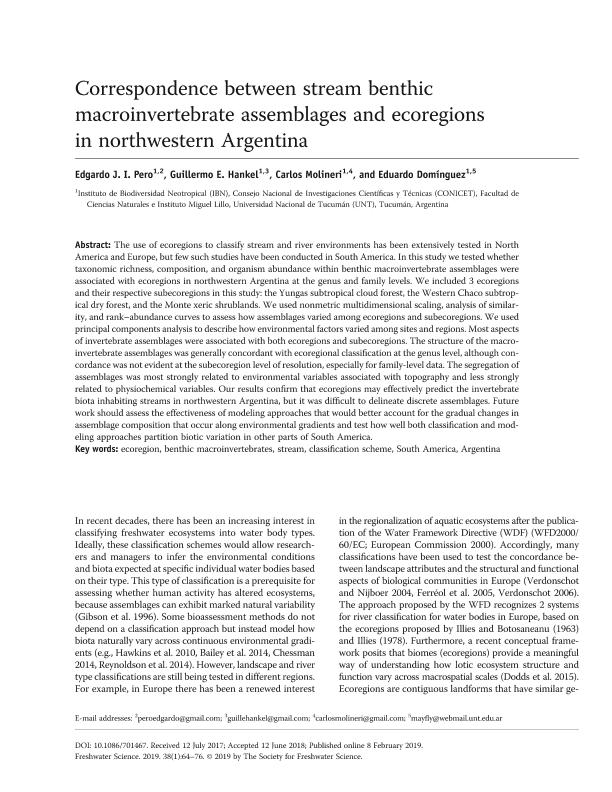Mostrar el registro sencillo del ítem
dc.contributor.author
Pero, Edgardo Javier Ignacio

dc.contributor.author
Hankel, Guillermo Eduardo

dc.contributor.author
Molineri, Carlos

dc.contributor.author
Domínguez, Eduardo
dc.date.available
2021-12-30T17:11:28Z
dc.date.issued
2019-02-08
dc.identifier.citation
Pero, Edgardo Javier Ignacio; Hankel, Guillermo Eduardo; Molineri, Carlos; Domínguez, Eduardo; Correspondence between stream benthic macroinvertebrate assemblages and ecoregions in northwestern Argentina; University of Chicago Press; Freshwater Science; 38; 1; 8-2-2019; 64-76
dc.identifier.issn
2161-9549
dc.identifier.uri
http://hdl.handle.net/11336/149462
dc.description.abstract
The use of ecoregions to classify stream and river environments has been extensively tested in North America and Europe, but few such studies have been conducted in South America. In this study we tested whether taxonomic richness, composition, and organism abundance within benthic macroinvertebrate assemblages were associated with ecoregions in northwestern Argentina at the genus and family levels. We included 3 ecoregions and their respective subecoregions in this study: the Yungas subtropical cloud forest, the Western Chaco subtropical dry forest, and the Monte xeric shrublands. We used nonmetric multidimensional scaling, analysis of similarity, and rank–abundance curves to assess how assemblages varied among ecoregions and subecoregions. We used principal components analysis to describe how environmental factors varied among sites and regions. Most aspects of invertebrate assemblages were associated with both ecoregions and subecoregions. The structure of the macroinvertebrate assemblages was generally concordant with ecoregional classification at the genus level, although concordance was not evident at the subecoregion level of resolution, especially for family-level data. The segregation of assemblages was most strongly related to environmental variables associated with topography and less strongly related to physiochemical variables. Our results confirm that ecoregions may effectively predict the invertebrate biota inhabiting streams in northwestern Argentina, but it was difficult to delineate discrete assemblages. Future work should assess the effectiveness of modeling approaches that would better account for the gradual changes in assemblage composition that occur along environmental gradients and test how well both classification and modeling approaches partition biotic variation in other parts of South America.
dc.format
application/pdf
dc.language.iso
eng
dc.publisher
University of Chicago Press
dc.rights
info:eu-repo/semantics/openAccess
dc.rights.uri
https://creativecommons.org/licenses/by-nc-sa/2.5/ar/
dc.subject
ARGENTINA
dc.subject
BENTHIC MACROINVERTEBRATES
dc.subject
CLASSIFICATION SCHEME
dc.subject
ECOREGION
dc.subject
SOUTH AMERICA
dc.subject
STREAM
dc.subject.classification
Ecología

dc.subject.classification
Ciencias Biológicas

dc.subject.classification
CIENCIAS NATURALES Y EXACTAS

dc.title
Correspondence between stream benthic macroinvertebrate assemblages and ecoregions in northwestern Argentina
dc.type
info:eu-repo/semantics/article
dc.type
info:ar-repo/semantics/artículo
dc.type
info:eu-repo/semantics/publishedVersion
dc.date.updated
2020-11-19T21:49:26Z
dc.journal.volume
38
dc.journal.number
1
dc.journal.pagination
64-76
dc.journal.pais
Estados Unidos

dc.journal.ciudad
Chicago
dc.description.fil
Fil: Pero, Edgardo Javier Ignacio. Consejo Nacional de Investigaciones Científicas y Técnicas. Centro Científico Tecnológico Conicet - Tucumán. Instituto de Biodiversidad Neotropical. Universidad Nacional de Tucumán. Facultad de Ciencias Naturales e Instituto Miguel Lillo. Instituto de Biodiversidad Neotropical. Instituto de Biodiversidad Neotropical; Argentina
dc.description.fil
Fil: Hankel, Guillermo Eduardo. Consejo Nacional de Investigaciones Científicas y Técnicas. Centro Científico Tecnológico Conicet - Tucumán. Instituto de Biodiversidad Neotropical. Universidad Nacional de Tucumán. Facultad de Ciencias Naturales e Instituto Miguel Lillo. Instituto de Biodiversidad Neotropical. Instituto de Biodiversidad Neotropical; Argentina
dc.description.fil
Fil: Molineri, Carlos. Consejo Nacional de Investigaciones Científicas y Técnicas. Centro Científico Tecnológico Conicet - Tucumán. Instituto de Biodiversidad Neotropical. Universidad Nacional de Tucumán. Facultad de Ciencias Naturales e Instituto Miguel Lillo. Instituto de Biodiversidad Neotropical. Instituto de Biodiversidad Neotropical; Argentina
dc.description.fil
Fil: Domínguez, Eduardo. Consejo Nacional de Investigaciones Científicas y Técnicas. Centro Científico Tecnológico Conicet - Tucumán. Instituto de Biodiversidad Neotropical. Universidad Nacional de Tucumán. Facultad de Ciencias Naturales e Instituto Miguel Lillo. Instituto de Biodiversidad Neotropical. Instituto de Biodiversidad Neotropical; Argentina
dc.journal.title
Freshwater Science
dc.relation.alternativeid
info:eu-repo/semantics/altIdentifier/doi/http://dx.doi.org/10.1086/701467
dc.relation.alternativeid
info:eu-repo/semantics/altIdentifier/url/https://www.journals.uchicago.edu/doi/abs/10.1086/701467
Archivos asociados
